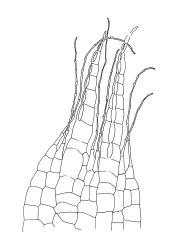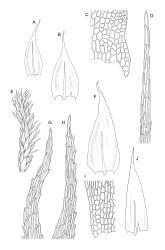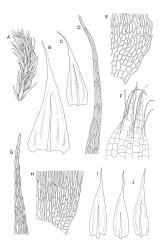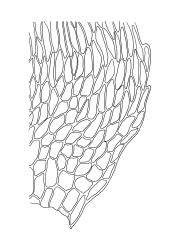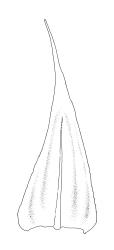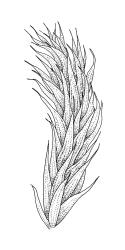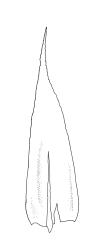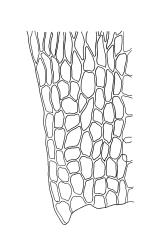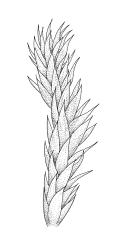- ≡ Hypnum rutabulum var. campestre Müll.Hal., Syn. Musc. Frond. 2, 368 (1851)
- = Brachythecium subpilosum var. angustifolium Allison, Trans. Roy. Soc. New Zealand 88: 9 (1960)
- ≡ Brachythecium allisonii Fife, Bryologist 98: 315 (1995)
Plants medium-sized, rather soft, yellow-green, forming loose mats. Stems apparently ascendant, irregularly branched, yellow- to pale brown, to at least 75 mm long, in cross-section with 3–4 layers of thick-walled cortical cells and a distinct central strand, beset below with brown, smooth rhizoids (in fascicles on abaxial side of leaf bases). Branches variable in length, weakly terete. Stem leaves erect-spreading to weakly secund, symmetric, strongly plicate (with several pleats extending ¾ or more the leaf length), scarcely altered when dry, ovate-lanceolate to lanceolate from a weakly auriculate base, evenly tapered to a narrowly acuminate apex, not or irregularly and weakly recurved at margins, weakly concave, not or slightly decurrent (decurrencies not visible under stereoscope), often strongly and sharply serrulate near apex, sometimes serrulate nearly to base, or occasionally entire or nearly so, 2.5–3.3 × 1.0–1.2 mm. Branch leaves somewhat smaller, strongly plicate, variably serrulate (mostly strongly and sharply serrulate but sometimes only finely serrulate at apices, with serrulations extending to base, or occasionally entire throughout, often with a few strong teeth at leaf base), often ± twisted at apices, (1.8–)2.1–2.5(3.0) × 0.5–0.8 mm. Costa (of branch leaves) c. 25–30 µm wide (⅓ above base), often obscured by plications, extending ⅔–¾ the length of the leaf, with or without a terminal spine. Upper laminal cells (of branch leaves) smooth, firm-walled, linear, 75–120 × 5–8 µm; basal cells shorter, wider and porose in c. 3–5 rows, not pigmented; alar cells neither inflated nor pigmented, firm-walled, subquadrate to ± oblong, forming a moderate-sized but ill-defined group (c. 4–8 cells along margin and reaching c. ⅓ to costa), sometimes with a few sharp marginal teeth.
Autoicous. Perichaetia scattered on stems, apparently enlarging after fertilisation; perichaetial leaves with an oblong base and quickly contracted to an acuminate apex, ecostate, entire, patent above, sheathing the lower seta. Perigonia ovoid, scattered on main stems, with ecostate, obovate-cuspidate bracts less than 1 mm long surrounding filiform, 6–7-celled paraphyses and c. 8 antheridia. Setae 15–25 mm, scabrose and weakly sinistrorse throughout, yellow-brown; capsules inclined to horizontal, asymmetric, oblong-ovoid, c. 1.7–2.0 mm (excluding operculum), pale or dark brown; exothecial cells mostly oblong, c. 40 µm; annulus not seen; operculum conic. Exostome teeth lanceolate; endostome with perforate segments and paired or single, nodose cilia, mostly c. ½ or more the height of the segments. Calyptra cucullate. Spores 15–24 µm, smooth or nearly so.
Ample and fruiting material is required for confident identification. The scabrose setae in B. campestre is the most reliable feature to distinguish it from the more common and similar B. salebrosum, which has a smooth seta. The larger stem leaves and the sometimes strongly and sharply serrulate nature of both the stem and branch leaves help to corroborate the distinction. The alar group here tends to be smaller and their component cells less quadrate when compared to B. salebrosum.
SI: Canterbury (Craigieburn Range), Otago (Flagstaff Hill in Dunedin, Mt Alfred).
Bipolar but possibly adventive in N.Z. Scattered but widely distributed in the northern hemisphere.
Known confidently from only three localities from which the collections are both ample and fertile. The earliest example, from Mt Alfred (CHR 472215A) was collected in Jan. 1892 by W. Bell from “grass crevices of rock” at an elevation of c. 340 m and determined soon afterwards by V.F. Brotherus. The Dunedin material was collected by K.W. Allison (CHR 379104) in 1955 from “on rotten log and on earth” from a “small open space” in a pine plantation at the “southern base” of Flagstaff Hill. The collection was probably made at an elevation of between 400 and 600 m. A second collection, lacking capsules but bearing scabrose setae, was made by K.W. Allison approximately two years after his first from “near the original finding” [at Flagstaff Hill]. He created the name Brachythecium subpilosum var. angustifolium to accommodate this material. A third collection referred here is from a much higher elevation, c. 1600 m at Mt Olympus in the Craigieburn Range, B.H. Macmillan 75/16 (CHR 229620). The leaves here are less strongly toothed (serrulate only in branch leaves but extending more or less to insertion), but otherwise match other N.Z. collections well. Only one detached seta with capsule and one attached but fragmented seta are present, but these are both scabrose. The collection from soil was gathered in a Chionochloa pallens–Celmisia grassland. One of the Flagstaff collections is mixed with Calliergonella cuspidata, Distichophyllum pulchellum, and Ptychomnion aciculare.
There are a small number of scant, often sterile, and mostly poorly documented collections in CHR named by various workers as close to or possibly B. campestre. None can be named with confidence and they are not discussed further here.
Neither Dixon (1929) nor Sainsbury (1955) discussed this species for N.Z., although Fife (1995) included it as a N.Z. species, without the citation of specimens, while simultaneously creating the name B. allisonii for material from Flagstaff Hill.
Crum & Anderson (1981, p. 1050) reviewed the opinions of various American and European workers concerning the status of this species and expressed the view that B. campestre is “troublesome and cannot be considered a species of the first rank”. This rather nebulous but succinct view applies to N.Z. material as much as it does to the North American.
This is a confusing taxon in a difficult genus. While, in a regional context, an argument could be made to treat the few ample collections as merely aberrant B. salebrosum, to do so would confuse the concept of that species, which has smooth setae. Such an argument would also ignore or counter efforts made by many authors to account for similar collections from other regions. Recognition of B. campestre as a rarely collected (or rarely recognised) N.Z. species is the most practical solution available. It is not clear whether this should be considered a native or an adventive species.



